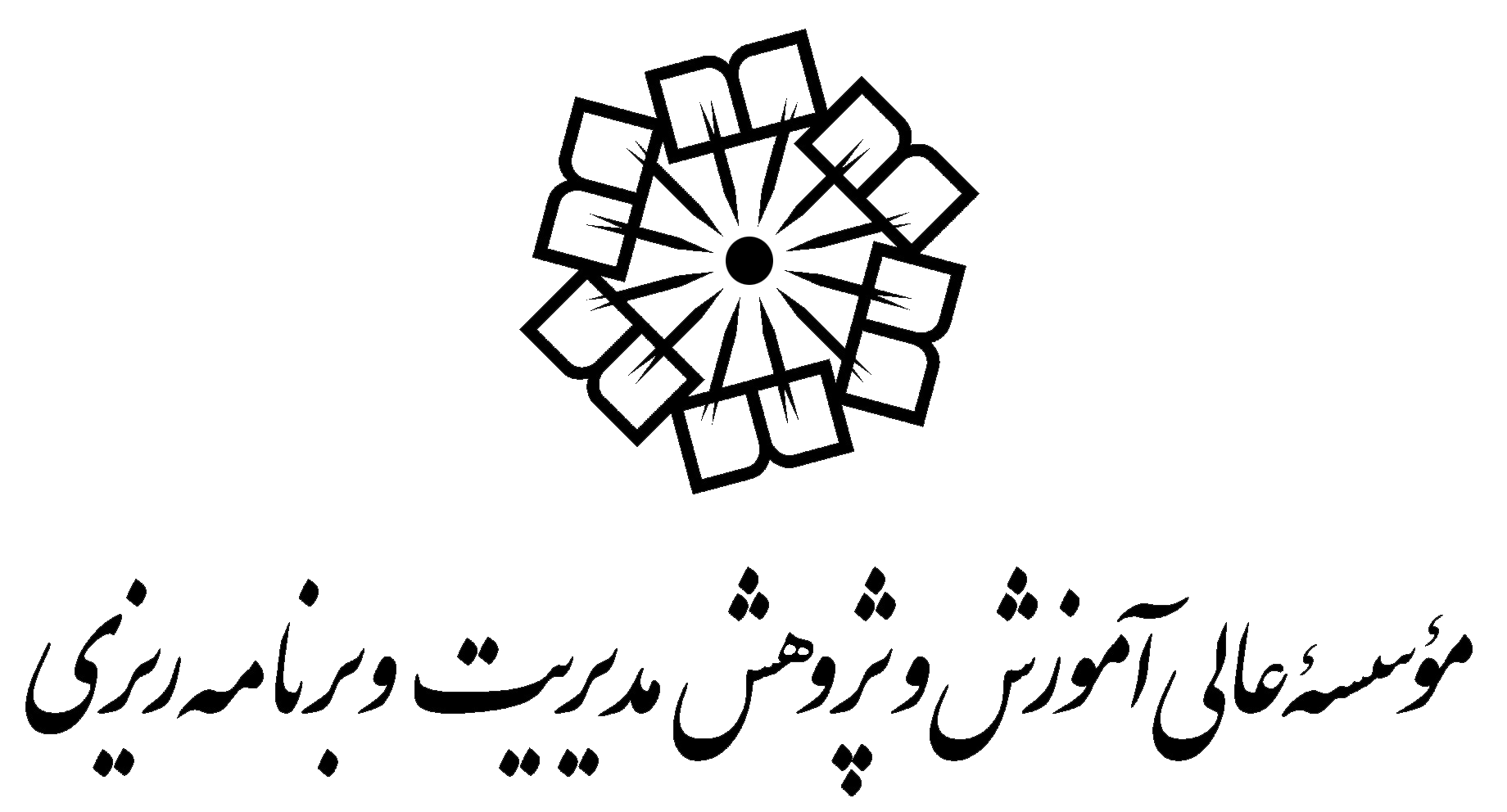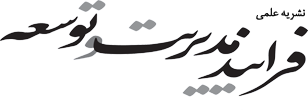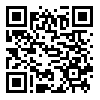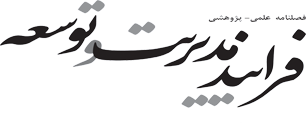دوره 37، شماره 4 - ( زمستان 1403 )
دوره37 شماره 4 صفحات 180-153 |
برگشت به فهرست نسخه ها
Download citation:
BibTeX | RIS | EndNote | Medlars | ProCite | Reference Manager | RefWorks
Send citation to:



BibTeX | RIS | EndNote | Medlars | ProCite | Reference Manager | RefWorks
Send citation to:
Ahmad Hosseini A, Mir S. (2025). Phenomenological Analysis of Competency Traps among sector public managers. JMDP. 37(4), 153-180. doi:10.61882/jmdp.37.4.153
URL: http://jmdp.ir/article-1-4797-fa.html
URL: http://jmdp.ir/article-1-4797-fa.html
احمدحسینی علی، میر سعید.(1403). تحلیل پدیدار شناسانه تلههای شایستگی مدیران در بخش دولتی فرایند مدیریت و توسعه 37 (4) :180-153 10.61882/jmdp.37.4.153
علی احمدحسینی1 
 ، سعید میر*2
، سعید میر*2 


 ، سعید میر*2
، سعید میر*2 

1- گروه مدیریت، واحد خوراسگان، دانشگاه آزاد اسلامی، اصفهان، ایران.
2- گروه مدیریت بازرگانی، واحد خرم آباد، دانشگاه آزاد اسلامی، خرم آباد، ایران. ،saeedmir63@yahoo.com
2- گروه مدیریت بازرگانی، واحد خرم آباد، دانشگاه آزاد اسلامی، خرم آباد، ایران. ،
چکیده: (1809 مشاهده)
هدف: تلههای شایستگی، به مجموعهای از روشها، رویهها، ارزشها و باورهای قدیمی گفته میشود که طی آن مدیران، تنها راهِ دستیابی به موفقیت و تعالی را، پایبندی به اصولِ ابتدایی، و فراگرفتهشده قدیمی، میدانند و هرگونه مسیرِ خارج از آن را نادرست، میپندارند. در واقع، میتوان گفت تلههای شایستگی، عوامل بازدارندهای هستند که با ایجادِ ایستایی و اینرسی در مدیران، آنها را در دامهایی، گیرانداخته و از شایستگی دور میکنند. لذا باتوجه به اهمیتِ موضوع، پژوهشِ حاضر با هدفِ تحلیلِ پدیدارشناسانه تلههای شایستگی مدیران سازمان دولتی؛ شناسایی ابعاد و پیامدهای تلههای شایستگی در یک سازمان دولتی، انجام پذیرفته است.
طرح پژوهش/ روششناسی/ رویکرد: پژوهشِ حاضر، از لحاظِ هدف، کاربردی و از لحاظِ نحوه گردآوری اطلاعات، توصیفی-اکتشافی و از نوعِ تحقیقات کیفی است، که با استفاده از روشِ پدیدار شناسی، و رویکردِ دیکلمن، انجام شده است. از آنجا که پژوهشِ حاضر، کیفی است روشِ جمع آوری اطلاعات در آن، مصاحبههای عمیق با مشارکت کنندگان است. در این پژوهش، به منظورِ بررسی و تحلیل دادههای حاصل از مصاحبه، از روشِ تحلیلِ محتوای کیفی و نرم افزار Maxqda استفاده شده است.
یافتهها: یافتههای پژوهش، علاوه بر شناخت و فهمِ پدیده مذکور، 15 بعد و 15 پیامد را، بهعنوانِ ابعاد و پیامدهای تلههای شایستگی مدیران شناسایی کرده است. بر این اساس، عدمِ درکِ تغییراتِ شرایط محیط سازمانی، عمل کردنِ مدیران، در محدوده خطکشی شده و راهجویی بر پایه دانش و تجربه پیشین، ازجمله ابعادِ تلههای شایستگیۀ، و ایجادِ عدمِ تطابقِ ارزشهای سازمانی، با فناوریهای موثرِ دفاعی، تضعیفِ رشد و توسعه فردی کارکنانِ ارتش، و ایجادِ سندرم پیری زودرس در سازمان، در زمره پیامدهای تلههای شایستگی قرار میگیرند.
طرح پژوهش/ روششناسی/ رویکرد: پژوهشِ حاضر، از لحاظِ هدف، کاربردی و از لحاظِ نحوه گردآوری اطلاعات، توصیفی-اکتشافی و از نوعِ تحقیقات کیفی است، که با استفاده از روشِ پدیدار شناسی، و رویکردِ دیکلمن، انجام شده است. از آنجا که پژوهشِ حاضر، کیفی است روشِ جمع آوری اطلاعات در آن، مصاحبههای عمیق با مشارکت کنندگان است. در این پژوهش، به منظورِ بررسی و تحلیل دادههای حاصل از مصاحبه، از روشِ تحلیلِ محتوای کیفی و نرم افزار Maxqda استفاده شده است.
یافتهها: یافتههای پژوهش، علاوه بر شناخت و فهمِ پدیده مذکور، 15 بعد و 15 پیامد را، بهعنوانِ ابعاد و پیامدهای تلههای شایستگی مدیران شناسایی کرده است. بر این اساس، عدمِ درکِ تغییراتِ شرایط محیط سازمانی، عمل کردنِ مدیران، در محدوده خطکشی شده و راهجویی بر پایه دانش و تجربه پیشین، ازجمله ابعادِ تلههای شایستگیۀ، و ایجادِ عدمِ تطابقِ ارزشهای سازمانی، با فناوریهای موثرِ دفاعی، تضعیفِ رشد و توسعه فردی کارکنانِ ارتش، و ایجادِ سندرم پیری زودرس در سازمان، در زمره پیامدهای تلههای شایستگی قرار میگیرند.
نوع مطالعه: پژوهشي |
موضوع مقاله:
ساختارهای اداری
دریافت: 1403/8/13 | پذیرش: 1404/2/16 | انتشار الکترونیک: 1404/6/26
دریافت: 1403/8/13 | پذیرش: 1404/2/16 | انتشار الکترونیک: 1404/6/26
فهرست منابع
1. Água, P. B., & Correia, A. (2021). Organizing for innovation in the armed forces: A logical thinking process approach. In Global perspectives on military entrepreneurship and innovation (pp. 283-305). IGI Global. [DOI:10.4018/978-1-7998-6655-8.ch014]
2. Ardalan, O. , Alvani, S. M. & Sharifian, M. E. (2018). Identification of the Most Important Components and Indicators of Creativity and Defensive Innovation in the Army of Islamic Republic of Iran Inspired by Religious Sources and Guidance from the Supreme Leader. Defence Studies, 16(4), 61-99. (In Persian)
3. Boyatzis, R.E. (1982). The Competent Manager: A Model for Effective Performance. Wiley, New York
4. Chapsal, A., & Guéron, Y. (2017). Competency Trap, Optimal Contracts and Limited Liability.
5. Chen, X., & Jiang, P. (2019, January). Competency Model-Based Improvement of Marketing Training Process Design. In 3rd International Seminar on Education Innovation and Economic Management (SEIEM 2018). Atlantis Press [DOI:10.2991/seiem-18.2019.56]
6. Cresswell, J.W. (2007). "Qualitative inquiry and research design": Choosingamong five approaches. Lincoln: Sage, London.
7. Cumming, G. S. (2018). A review of social dilemmas and social-ecological traps in conservation and natural resource management. Conservation Letters, 11(1), e12376. [DOI:10.1111/conl.12376]
8. Davoodi E, Vedadi A, rezaeiyan A, gholamzadeh D. (2021). Designing a Competency Model for Senior Managers of Gas Refineries in South Pars Gas Complex (S.P.G.C.). JMDP. 33(4), 71-96. (In Persian) [DOI:10.52547/jmdp.33.4.71]
9. Denrell, J., & Le Mens, G. (2020). Revisiting the competency trap. Industrial and Corporate Change, 29(1), 183-205. [DOI:10.1093/icc/dtz072]
10. Diekelmann, N. L. (1993). Behavioral pedagogy: A Heideggerian hermeneutical analysis of the lived experiences of students and teachers in baccalaureate nursing education. Journal of nursing education, 32(6), 245-250. [DOI:10.3928/01484834-20040601-02] [PMID] [https://doi.org/10.3928/0148-4834-19930601-04]
11. Golshahi, B. , Sadeghi Nasab, M. & Moradi Dommeneh, G. (2023). A Structural Model of Transformation in Human Capital Management of the Army's Islamic Republic of Iran. Military Science and Tactics, 19(63), 33-62. (In Persian)
12. Jackson, N. C. (2019). Managing for competency with innovation change in higher education: Examining the pitfalls and pivots of digital transformation. Business Horizons, 62(6), 761-772. [DOI:10.1016/j.bushor.2019.08.002]
13. Lincoln, Y. S., & Guba, E. G. (1985). Naturalistic Inquiry. Beverly Hills, CA: Sage Publications, Inc. [DOI:10.1016/0147-1767(85)90062-8]
14. Matsuo, M. (2021). Unlearning at work: insights for organizations. Gateway: Springer. [DOI:10.1007/978-981- 16-3799-5]
15. Misra, Y., & Sharma, V. (2017). An exploratory study on business strategy, competency and firm performance
16. McClelland, D. C. (1973). Testing for competence rather than for" intelligence.". American psychologist, 28(1), 1. [DOI:10.1037/h0034092] [PMID]
17. Mu, W., & Jiang, X. (2024). Absorptive capacity versus competency trap: Experiential knowledge and investment in emerging technologies. Technovation, 131, 102973. [DOI:10.1016/j.technovation.2024.102973]
18. Müller-Frommeyer, L. C., Aymans, S. C., Bargmann, C., Kauffeld, S., & Herrmann, C. (2017). Introducing competency models as a tool for holistic competency development in learning factories: Challenges, example and future application. Procedia Manufacturing, 9, 307-314. [DOI:10.1016/j.promfg.2017.04.015]
19. Pan, W., Sun, L. Y., & Lam, L. W. (2020). Employee-organization exchange and employee creativity: A motivational perspective. The International Journal of Human Resource Management, 31(3), 385-407. [DOI:10.1080/09585192.2017.1331368]
20. Rath, A., & Jena, L. K. (2024). I don't want to switch! So, am I trapped? An in-depth qualitative inquiry of resistance to change leading to competency trap. Development and Learning in Organizations: An International Journal. [DOI:10.1108/DLO-09-2023-0192]
21. Rajebi A, Maleki Avarsin S, Daneshvar Heris Z. (2022). A Competency Model for the Training and Development Administrators of Local Government Organizations of East Azerbaijan Province. JMDP. 34(4), 119-144. (In Persian) [DOI:10.52547/jmdp.34.4.119]
22. Sanghi, S. (2016). The handbook of competency mapping: understanding, designing and implementing competency models in organizations. SAGE publications India. [DOI:10.4135/9789353280352]
23. Saukh, I., & Vikarchuk, O. (2021). Creativity in management and creative management: meta-analysis. [DOI:10.21272/mmi.2021.1-06]
24. Shiri, A., Bagherzadeh, R., & Ghasempour, H. (2024). Competency trap in public organizations: an exploration of its antecedents and consequences. Journal of Strategic Management Studies, 15(58), 171-192. (In Persian)
25. Sonmez Cakir, F., & Adiguzel, Z. (2023). Effects of innovative finance, strategy, organization and performance: a case study of company. International Journal of Innovation Science, 15(1), 42-58. [DOI:10.1108/IJIS-08-2021-0146]
26. Svejenova, S. (2019). Constructive pluralism for a theory of organization: Rediscovering our community, identity, and vocation. Organization Studies, 40(1), 59-64. [DOI:10.1177/0170840618767467]
27. Ulrich, B., Harper, M. G., Maloney, P., Warren, J. I., Whiteside, D., & MacDonald, R. (2024). National Preceptor Competency Consensus Study. JONA: The Journal of Nursing Administration, 10-1097. [DOI:10.1097/NNA.0000000000001523] [PMID]
28. Van Manen, M. (2016). Researching lived experience: Human science for an action sensitive pedagogy. Routledge.
29. Yilmaz, A. A., & Tuzlukaya, S. E. (2022). Competency Trap in Organizational Learning: Turkish E-Government Gateway Application During the COVID-19 Pandemic. International Journal of Electronic Government Research (IJEGR), 18(1), 1-13 [DOI:10.4018/IJEGR.288068]
| بازنشر اطلاعات | |
 |
این مقاله تحت شرایط Creative Commons Attribution 4.0 International License قابل بازنشر است. |





